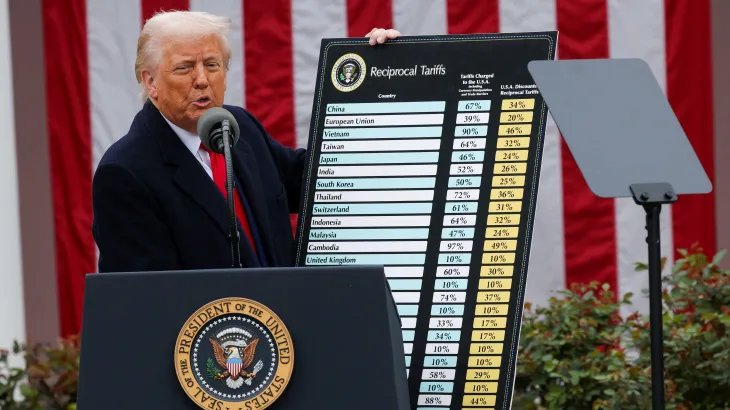The Tariff Tsunami: Did Trump Just Break Globalization?

- Executive Summary
- Introduction: The Declaration of « Liberation Day »
- The « Liberation Day » Announcement: Unveiling the New Tariff Policies
- Rationale and Objectives: The « Economic Independence » Argument
- Immediate Reactions from Financial Markets and Key Stakeholders
- Economic Analysis: Anticipated Impacts and Expert Opinions
- International Responses and the Risk of Trade Wars
- Political and Social Implications: Public Opinion and Counter-Narratives
- Conclusion: Assessing the Significance of « Liberation Day »:
Executive Summary
On April 2, 2025, President Donald Trump declared this day « Liberation Day, » coinciding with the announcement of significant new tariffs on imports to the United States. This move, framed as a declaration of economic independence, introduced a two-tiered tariff system involving a baseline 10% levy on nearly all imports and additional « reciprocal » tariffs on approximately 90 countries. The stated objectives behind these policies include bolstering domestic manufacturing, rectifying perceived unfair trade practices, and reducing the nation’s trade deficit. However, the announcement triggered an immediate negative reaction from financial markets and elicited widespread skepticism from economists who foresee increased consumer prices and a heightened risk of global trade conflicts. While some domestic industries and political figures offered support, many stakeholders, both within the U.S. and internationally, expressed serious concerns about the potential economic and diplomatic repercussions of these sweeping trade measures.
Introduction: The Declaration of « Liberation Day »
President Donald Trump designated April 2, 2025, as « Liberation Day » during a ceremony held in the White House Rose Garden.1 This event served as the platform for unveiling a comprehensive overhaul of the United States’ global trade policy.1 In his address, President Trump characterized this day as a monumental occasion, equating it to the United States’ « declaration of economic independence ».1 This rhetoric emphasized a perceived need to break away from existing international trade arrangements, which the administration viewed as detrimental to American interests. It is noteworthy that President Trump had previously employed the term « Liberation Day » to describe other significant junctures, including the day of the presidential election and his inauguration.3 This recurring use of the phrase underscores the profound importance he attributes to the newly announced tariff policies, positioning them as a pivotal moment in American economic history and a decisive step towards national resurgence.1 The consistent application of this powerful label across different key events suggests a deliberate strategy to brand his policies as transformative, aiming to resonate with a narrative of decisive action and a return to a state of perceived national strength or autonomy, particularly in the realm of international trade.
The « Liberation Day » Announcement: Unveiling the New Tariff Policies
The centerpiece of President Trump’s « Liberation Day » announcement was the unveiling of a two-tiered tariff structure designed to reshape the landscape of American imports.1 The first component of this structure is a baseline tariff of 10% applied to imports from nearly all countries.1 This broad tariff, set to take effect on April 5, 2025, signifies a widespread increase in the cost of goods entering the United States.1 Complementing this universal tariff is a set of additional « reciprocal » tariffs targeting approximately 90 countries.1 These supplementary tariffs, slated to go into effect on April 9, 2025, are specifically aimed at nations that the Trump administration deems to have engaged in unfair trade practices, suggesting a more punitive approach towards these perceived offenders.1
The specific rates for these reciprocal tariffs vary significantly across major trading partners, reflecting the administration’s assessment of the trade imbalances and perceived unfairness of trade relationships.1 For instance, imports from China will face a cumulative tariff rate of 54%, comprising the baseline 10% plus an additional 34%.1 Goods from the European Union will be subject to a 20% tariff 1, while Vietnam will see a 46% duty 1, Japan 24% 1, India 26% 1, South Korea 25% 1, Cambodia 49% 1, and Taiwan 32%.1
Despite the broad scope of these tariffs, several key exemptions were announced.1 Most notably, Canada and Mexico were largely spared from the new reciprocal tariffs, although exceptions remain for certain automotive, steel, and aluminum products.1 Additionally, goods already subject to Section 232 tariffs, including steel, aluminum, automobiles, and auto parts, are also exempt.1 Certain essential goods such as copper, pharmaceuticals, semiconductors, lumber, gold, energy, and specific minerals not readily available in the U.S. are also excluded from the reciprocal tariffs.1 Furthermore, goods qualifying under the United States–Mexico–Canada Agreement (USMCA) are generally exempt.5 In a related move, the Trump administration announced the elimination of the $800 de minimis threshold for duty-free imports from China, effective May 2, 2025, with intentions to extend this policy to other countries in the future.1 It is crucial to note that the announced reciprocal tariffs are additive, meaning they will be applied on top of the baseline 10% tariff, potentially leading to significant increases in the cost of imported goods from targeted nations.5
The intricate nature of this tariff structure, characterized by numerous exemptions and varying rates, suggests a deliberate effort to target specific industries and countries perceived by the administration to be engaging in unfair trade practices. This targeted approach aims to maximize pressure on these entities while potentially mitigating broader economic disruption. However, the complexity inherent in such a system inevitably introduces uncertainty and raises the possibility of unintended consequences for businesses and consumers navigating this new trade environment.
Rationale and Objectives: The « Economic Independence » Argument
President Trump articulated a multi-faceted rationale for the implementation of these new tariffs, framing them as essential for the economic well-being and national security of the United States.1 A primary objective is to revitalize American manufacturing and generate employment opportunities within the country.1 The administration contends that by increasing the cost of imported goods, domestic producers will become more competitive, leading to increased production and a repatriation of jobs previously held overseas. Furthermore, these tariffs are presented as a punitive measure against countries accused of long-standing unfair trade practices and the imposition of disproportionate duties on American goods.1 President Trump has used strong rhetoric to describe the situation, asserting that the U.S. has been subjected to economic exploitation by other nations for too long.14
A key justification for these tariffs is the administration’s concern over the persistent trade deficit, which President Trump has declared a national emergency that undermines both national and economic security.1 By imposing tariffs, the aim is to reduce the volume of imports and encourage domestic consumption, thereby narrowing the trade gap. The overarching goal, as the moniker « Liberation Day » suggests, is to achieve « economic independence » for the United States, reducing its reliance on foreign goods and supply chains.1 The administration also hopes that these tariffs will incentivize foreign businesses to establish manufacturing facilities within the U.S. to circumvent the import duties.2 Additionally, a stated objective is to generate substantial revenue through these tariffs, which could then be used to reduce domestic taxes and contribute to paying down the national debt.1 Beyond traditional tariffs, the administration aims to counter other perceived unfair trade practices such as currency manipulation and restrictive regulations that limit the access of U.S. exports to foreign markets.6
The concept of « reciprocal tariffs » lies at the heart of this new trade policy.2 The administration asserts that these tariffs are designed to mirror the duties that other countries impose on American exports, although President Trump indicated that the U.S. would initially impose tariffs at roughly half the rate of those levied by other nations, framing this as a « kind » approach.2 This strategy is based on the argument that the post-World War II international economic system was founded on the principle of reciprocity in trade, which the Trump administration believes has been eroded over time, necessitating these measures to restore balance and fairness.7
The rationale presented by the Trump administration intertwines economic and national security considerations, portraying the tariffs as a necessary intervention to correct perceived imbalances, safeguard domestic industries, and ensure the long-term prosperity and security of the United States. The emphasis on « reciprocity » serves to legitimize the tariffs as a proportionate response to what the administration views as unfair treatment by other nations in the global trading system. However, the claim of generating trillions of dollars in revenue through these tariffs is met with considerable skepticism from economists, who offer alternative analyses of the likely economic impacts.
Immediate Reactions from Financial Markets and Key Stakeholders
The announcement of the « Liberation Day » tariffs was met with an immediate and largely negative response from financial markets, reflecting investor concerns about the potential economic repercussions of these sweeping trade measures.1 Following the announcement, futures for major stock market indexes, including the S&P 500, the Dow Jones Industrial Average, and the Japanese Nikkei 225, experienced significant declines, signaling an anticipated downturn in equity prices.1 Trading on Wall Street the following day saw major indexes edge lower, indicating a cautious and somewhat pessimistic market sentiment in the wake of the tariff news.15 Technology stocks, in particular, faced considerable downward pressure, with several major tech companies experiencing notable drops in their stock values.5 The automotive sector also witnessed volatility, with shares of some U.S. automakers declining, while electric vehicle manufacturers and auto parts retailers saw gains, suggesting a complex and differentiated impact within the industry.15
Reactions from business organizations were varied, reflecting the diverse interests and potential impacts across different sectors.4 The National Association of Manufacturers voiced concerns about the potential negative consequences of the tariffs on investment, job creation, and supply chain stability.4 Similarly, the National Restaurant Association expressed worries that the tariffs would lead to increased costs for food imports, ultimately resulting in higher prices for consumers.4 In contrast, the Alliance for American Manufacturing offered a more positive assessment, suggesting that the tariffs prioritize U.S. manufacturers and workers who have long suffered from unfair trade practices.4 The U.S. Chamber of Commerce cautioned that while the goals of fair trade are laudable, the broad application of these tariffs could undermine long-term economic growth and harm American consumers and businesses.9
Political reactions to the « Liberation Day » tariffs also revealed a significant divide.1 Senate Democrats overwhelmingly opposed the new tariffs, characterizing them as a tax that would disproportionately burden American families.1 Some Republican leaders, while generally supportive of the president’s trade agenda, acknowledged the potential for short-term economic disruption but expressed optimism that the policies would ultimately benefit the American economy.1 Governors of several states raised concerns about the potential negative impacts of the tariffs on their respective state economies, particularly those heavily reliant on international trade.1 Notably, the Senate passed a measure aimed at blocking the tariffs on Canada, indicating some bipartisan unease with the administration’s approach.5 Outside the White House, protestors gathered to voice their opposition to the tariffs, holding signs that criticized the policy as benefiting wealthy interests at the expense of consumers.1
The immediate negative reaction from financial markets underscores the significant uncertainty and potential risks that investors associate with the newly announced tariffs. The mixed responses from business organizations and the clear partisan divide in political reactions highlight the complex and potentially disruptive nature of these policies, with some sectors and political groups anticipating benefits while others foresee substantial challenges and negative consequences.
Economic Analysis: Anticipated Impacts and Expert Opinions
The economic implications of President Trump’s « Liberation Day » tariffs have been the subject of extensive analysis and debate among economists, with a prevailing view that these measures are likely to have negative consequences for the U.S. economy.2 A primary concern is the anticipated increase in prices for American consumers across a wide range of goods, including automobiles, groceries, and housing.1 Economists generally agree that tariffs are essentially a tax on imports, and businesses importing goods subject to these tariffs will likely pass on these increased costs to consumers in the form of higher prices. This could erode the purchasing power of American households and potentially lead to a decrease in consumer spending.
Furthermore, many economists predict that the tariffs will lead to lower corporate profits and a slowdown in overall economic growth.3 Increased costs for businesses that rely on imported components or materials could reduce their profitability, potentially leading to decreased investment and hiring. The uncertainty surrounding the long-term implications of these tariffs could also dampen business confidence and further contribute to slower economic activity. There are also significant concerns about the risk of inflation.2 By increasing the cost of imported goods, the tariffs could put upward pressure on prices across the economy, potentially negating any benefits from wage growth and further straining household budgets.
The implementation of these broad tariffs also raises concerns about potential disruptions to global supply chains, particularly in complex industries like automotive manufacturing that rely on intricate international networks for parts and assembly.4 Increased tariffs could force companies to restructure their supply chains, which can be costly and time-consuming, potentially leading to production delays and further price increases. Estimates from various economic analyses suggest that the average American household could face a significant increase in annual expenses as a result of these tariffs.12 While the Trump administration has suggested that the tariffs could generate trillions of dollars in revenue, economists are largely skeptical of such claims, arguing that the actual revenue generated will likely be far lower and will come at the cost of higher prices for consumers.5 Some economists also suggest that the impact of tariffs could extend beyond goods to affect the pricing of services as well, as increased costs for imported goods used in service industries could eventually be passed on to consumers.3
Despite the prevailing negative outlook, there are some differing perspectives. For example, the president of the United Auto Workers (UAW) has stated that tariffs can be a useful tool to encourage companies to invest in American workers and bring jobs back to the U.S., although he also noted that they are not a complete solution to the challenges facing American manufacturing.5 However, the overwhelming consensus among mainstream economists is that the « Liberation Day » tariffs will likely result in negative economic consequences for the United States, primarily through increased consumer prices and potential damage to overall economic growth. While the administration argues for potential long-term benefits in terms of increased domestic manufacturing, most experts anticipate more immediate and tangible pain for both consumers and businesses.
International Responses and the Risk of Trade Wars
The announcement of President Trump’s « Liberation Day » tariffs has elicited strong reactions from other countries and international bodies, significantly increasing the risk of a global trade war.3 Several major trading partners, including China and the European Union, have already announced their intentions to retaliate with their own countermeasures, raising the specter of escalating tariffs on both sides.3 This tit-for-tat approach could lead to a cycle of protectionism that harms international trade and economic growth for all involved nations.
Japan’s reaction to the announcement was one of deep regret, with the Japanese government indicating that it is considering all available options to respond to the newly imposed duties.4 Canada’s Prime Minister vowed to vigorously defend Canadian workers and industries against the impact of the U.S. tariffs, suggesting a firm stance against the new trade barriers.3 Leaders across Europe have also condemned the tariffs. The President of the European Commission announced that the EU is preparing further countermeasures, referencing existing tariffs on steel and aluminum as a precedent.4 Other European leaders described the tariffs as misguided, deeply regrettable, and an attack on fair trade, expressing a desire to return to a path of trade and cooperation.5 The President of France warned that the tariffs would disrupt global value chains, create inflation, and ultimately lead to job losses, not only in the U.S. but also in Europe, Canada, and Mexico.3
The strong negative reactions and explicit threats of retaliation from key trading partners underscore the significant potential for an escalation of global trade tensions. When one country imposes broad tariffs, it often prompts affected nations to respond in kind, leading to a cycle of escalating trade barriers. This can disrupt established international trade relationships, increase costs for businesses operating globally, and ultimately harm consumers through higher prices and reduced choices. The readiness of major economic powers like China and the European Union to announce countermeasures suggests a serious escalation of trade tensions, with potentially far-reaching consequences for the global economy and international relations.
Political and Social Implications: Public Opinion and Counter-Narratives
Public sentiment surrounding President Trump’s « Liberation Day » tariffs appears to be largely skeptical, with many Americans expressing concerns about the potential for increased prices and negative economic impacts.1 Polls conducted prior to and following the announcement indicate that a significant majority of Americans believe tariffs will make products more expensive, and a substantial portion anticipates that these policies will harm the overall economy.20 The negative reaction from financial markets, including the drop in stock market futures, also suggests a broader public concern about the potential economic fallout from these tariffs.1 Protests that took place outside the White House following the « Liberation Day » announcement further illustrate the public opposition to the new trade policies.1
Despite the prevailing skepticism, there is some level of support for the tariffs, particularly from labor unions like the UAW, which view them as a tool to encourage domestic investment and protect American jobs.5 However, counter-narratives and criticisms surrounding the concept of « Liberation Day » and the associated tariffs are widespread.1 Critics argue that the tariffs represent a significant tax increase on American consumers, who will ultimately bear the burden of higher prices for a wide range of goods.1 There are also concerns that the policies primarily benefit wealthy corporations and special interests rather than the average American consumer.1 The unilateral nature of the president’s decision to impose these tariffs has also drawn criticism, with some arguing that such significant trade policy changes should require congressional approval.1
Some analysts suggest that the tariffs may be motivated by political considerations rather than sound economic policy, potentially serving as a tool to exert influence over private industries.14 Free trade advocates warn that the tariffs will not only raise prices for U.S. consumers but also harm business investment, slow down economic growth, and provoke retaliatory measures from other countries.5 Some economists have even raised the possibility that the tariffs could trigger a recession due to the significant disruption they are expected to cause to the economy.14 The overall public sentiment appears to be one of concern and uncertainty regarding the potential consequences of President Trump’s « Liberation Day » tariffs, with a significant portion of the population skeptical about the administration’s claims of economic benefits.
Conclusion: Assessing the Significance of « Liberation Day »:
President Trump’s declaration of April 2, 2025, as « Liberation Day » and the subsequent announcement of sweeping new tariffs mark a significant escalation in global trade tensions. The administration’s rationale centers on the goals of revitalizing domestic manufacturing, addressing what it perceives as unfair trade practices by other nations, and reducing the persistent trade deficit. The implementation of a two-tiered tariff structure, featuring a baseline 10% levy and additional reciprocal tariffs on numerous countries, represents a bold and potentially disruptive shift in U.S. trade policy.
While the administration expresses confidence that these measures will lead to long-term economic benefits and greater national economic independence, the immediate reactions and expert analyses paint a more cautious picture. Financial markets responded negatively to the announcement, reflecting investor concerns about the potential for economic disruption. Economists largely agree that the tariffs are likely to result in increased consumer prices, potentially slower economic growth, and a heightened risk of inflation. The threat of retaliatory measures from major trading partners further compounds these concerns, raising the specter of a global trade war that could have far-reaching negative consequences.
Public opinion appears to be largely skeptical of the « Liberation Day » tariffs, with many Americans worried about rising prices and the potential for economic harm. Counter-narratives emphasize the burden on consumers and question the economic rationale behind the policies. While some domestic industries and political figures have voiced support, the overall assessment based on available information and expert analysis suggests that President Trump’s « Liberation Day » tariffs pose significant risks to the U.S. and global economies. The long-term impacts will depend on how these policies are implemented, the responses from other countries, and the adaptability of businesses and consumers to this new trade environment.
Key Figures:
- Table: Summary of Key Tariff Rates Announced on « Liberation Day » (April 2, 2025)
| Country | Baseline Tariff Rate | Reciprocal Tariff Rate | Cumulative Tariff Rate | Effective Date |
| China | 10% | 34% | 54% | April 9, 2025 |
| European Union | 10% | 20% | 20% | April 9, 2025 |
| Vietnam | 10% | 46% | 46% | April 9, 2025 |
| Japan | 10% | 24% | 24% | April 9, 2025 |
| India | 10% | 26% | 26% | April 9, 2025 |
| South Korea | 10% | 25% | 25% | April 9, 2025 |
| Cambodia | 10% | 49% | 49% | April 9, 2025 |
| Taiwan | 10% | 32% | 32% | April 9, 2025 |
- Table: Summary of Reactions to « Liberation Day » Tariffs
| Stakeholder Category | Specific Entity/Individual | Key Reaction/Statement |
| Financial Markets | S&P 500 Futures | Tumbled more than 3% following the announcement |
| Financial Markets | Dow Jones Futures | Lost more than 1,000 points (2.5% decline) |
| Business Organizations | National Association of Manufacturers | Described announcement as « complicated » and expressed concern about potential negative impacts |
| Business Organizations | National Restaurant Association | Worried that tariffs will increase costs and lead to higher prices for consumers |
| Political Figures | Senate Democrats | Voiced opposition, characterizing tariffs as a « tax on almost everything families buy » |
| Political Figures | European Commission President Ursula von der Leyen | Announced the EU is preparing further countermeasures |
| International Bodies | China Ministry of Commerce | Stated it « firmly opposes this and will take countermeasures to safeguard its own rights and interests » |
| Public Reaction | Protestors | Gathered outside the White House with signs criticizing the policy as benefiting wealthy interests at consumers’ expense |
REFERENCES
- Donald Trump’s Liberation Day speech – Wikipedia, accessed April 3, 2025, https://en.wikipedia.org/wiki/Donald_Trump%27s_Liberation_Day_speech
- Trump reveals these 2 new types of tariffs on what he calls « Liberation Day, » April 2, accessed April 3, 2025, https://www.cbsnews.com/news/liberation-day-trump-tariffs-explained/
- Trump’s promised ‘Liberation Day’ of tariffs is coming. Here’s what it could mean for you – AP News, accessed April 3, 2025, https://apnews.com/article/trump-new-tariffs-liberation-day-import-taxes-118d73f50e5133ef3d9598aed6661a6c
- Five key takeaways from Trump’s ‘Liberation Day’ reciprocal tariffs – Al Jazeera, accessed April 3, 2025, https://www.aljazeera.com/economy/2025/4/3/five-key-takeaways-from-trumps-liberation-day-reciprocal-tariffs
- Key moments and reaction to Trump’s « Liberation Day » announcement of new tariffs, accessed April 3, 2025, https://www.cbsnews.com/live-updates/trump-liberation-day-announcement-tariffs/
- What are Trump’s new reciprocal tariffs and how will they impact trade?, accessed April 3, 2025, https://m.economictimes.com/news/international/global-trends/trump-tariffs-what-are-trumps-new-reciprocal-tariffs-and-how-will-they-impact-trade/articleshow/119923954.cms
- Fact Sheet: President Donald J. Trump Declares National Emergency to Increase our Competitive Edge, Protect our Sovereignty, and Strengthen our National and Economic Security – The White House, accessed April 3, 2025, https://www.whitehouse.gov/fact-sheets/2025/04/fact-sheet-president-donald-j-trump-declares-national-emergency-to-increase-our-competitive-edge-protect-our-sovereignty-and-strengthen-our-national-and-economic-security/
- Trump announces sweeping new tariffs to promote US manufacturing, risking inflation and trade wars – Star Tribune, accessed April 3, 2025, https://www.startribune.com/trump-announces-sweeping-new-tariffs-to-promote-us-manufacturing-risking-inflation-and-trade-wars/601316381
- Trump announces new tariffs on what he calls « Liberation Day » amid fears of higher prices, accessed April 3, 2025, https://www.cbsnews.com/news/trump-liberation-day-new-tariffs-us/
- President Trump Imposes Reciprocal Tariffs on Most Countries, Covering Most Goods, accessed April 3, 2025, https://www.kelleydrye.com/viewpoints/client-advisories/president-trump-imposes-reciprocal-tariffs-on-most-countries-covering-most-goods
- How Trump’s ‘liberation day’ tariffs will transform global trade – Atlantic Council, accessed April 3, 2025, https://www.atlanticcouncil.org/content-series/fastthinking/how-trumps-liberation-day-tariffs-will-transform-global-trade/
- Trump is set to announce ‘reciprocal’ tariffs in a risky move that could reshape the economy – AP News, accessed April 3, 2025, https://apnews.com/article/trump-tariffs-liberation-day-2a031b3c16120a5672a6ddd01da09933
- Trump has dubbed April 2 ‘Liberation Day’ for tariffs. Here’s what to expect – AP News, accessed April 3, 2025, https://apnews.com/article/trump-reciprocal-tariffs-liberation-day-april-2-86639b7b6358af65e2cbad31f8c8ae2b
- April 2, 2025 (Wednesday) – by Heather Cox Richardson, accessed April 3, 2025, https://heathercoxrichardson.substack.com/p/april-2-2025-wednesday
- Stock market today: Wall Street slips following Trump’s latest tariffs, despite solid economic data – AP News, accessed April 3, 2025, https://apnews.com/article/stocks-markets-tariffs-rates-autos-df6909dce420a676fa8e74d161451ad3
- Stock market today: Trump’s tariff hikes pull Asian shares, US futures sharply lower, accessed April 3, 2025, https://apnews.com/article/stocks-markets-rates-tariffs-52dbb020a4c41122e31669c2da236d67
- A jittery Wall Street rides the tariff roller coaster and appears headed for big losses on Thursday | AP News, accessed April 3, 2025, https://apnews.com/article/financial-markets-trump-tariffs-liberation-day-7b5da6b0302cbd6d6ca105d48256384c
- Stocks tumble as Wall Street braces for Trump’s April 2 tariff announcement – CBS News, accessed April 3, 2025, https://www.cbsnews.com/news/stocks-down-djia-sp-500-trump-tariffs-liberation-day/
- Markets News, April 2, 2025: Stocks Plunge in Extended Trading After Rising Ahead of Trump Tariff Announcement – Investopedia, accessed April 3, 2025, https://www.investopedia.com/dow-jones-today-04022025-11707447
- Americans are deeply skeptical of Trump’s ‘Liberation Day’ tariffs – Reason Magazine, accessed April 3, 2025, https://reason.com/2025/04/02/americans-are-deeply-skeptical-of-trumps-liberation-day-tariffs/





